Some wheelguns are unqualified classics. In this Smith & Wesson Model 66 review, I take a close look at two modern versions of one of those iconic revolvers.
Dubbed a Combat Magnum, there is little doubt that Smith & Wesson designed the original gun for serious business. Widely respected, the original Model 66 served law enforcement and armed citizens for nearly 50 years. As they say, all good things come to an end, and the Model 66 could not escape the downturn in the revolver market.
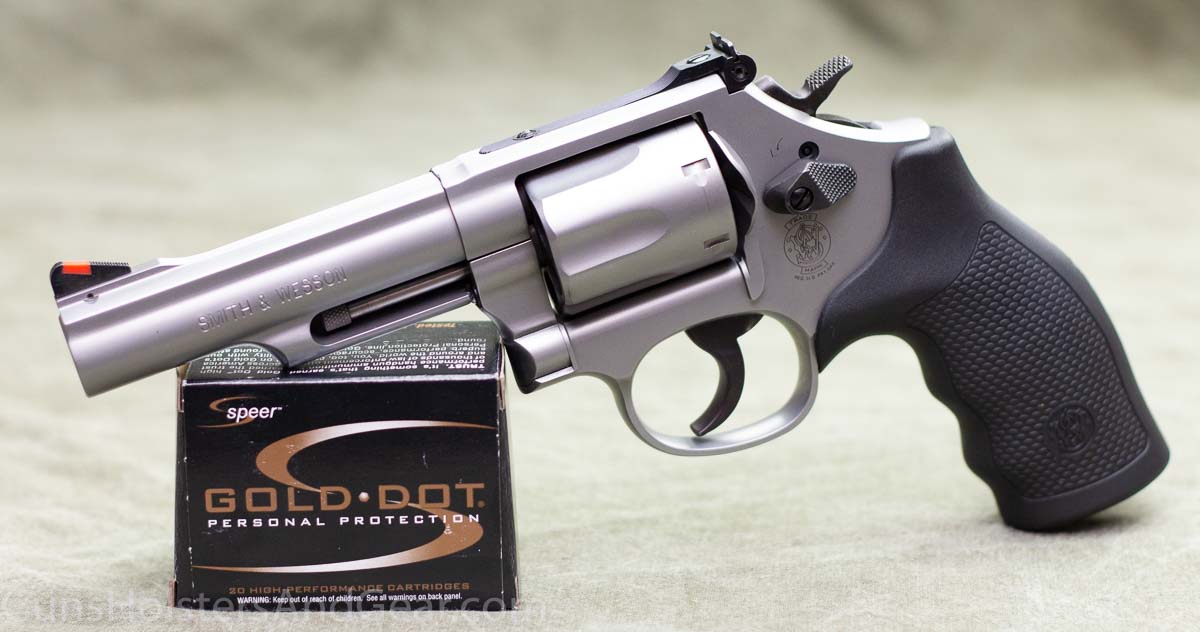
But that wasn’t the final chapter in the book on this classic handgun. Nearly 10 years after the gun was dropped from the company catalog, Smith & Wesson reintroduced the Model 66 Combat Magnum. Then, the company expanded the line with a shorter barreled version of the legendary six-shooter.
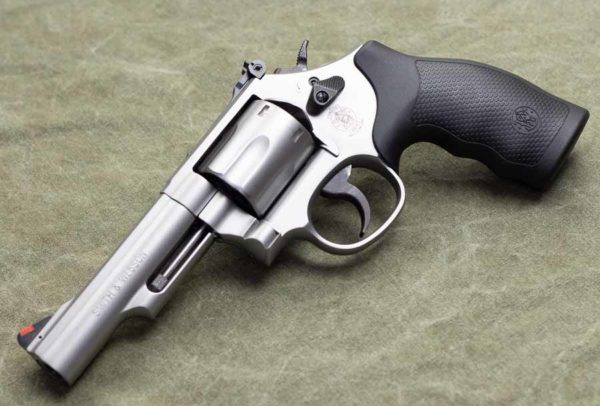
Where to Buy the S&W Model 66
The Model 66 is available at many local gun shops and through our affiliate links here:
- Palmetto State Armory: 4.25″ model, 2.75″ model
- Guns.com (both new and classic models)
- Sportsman’s Warehouse: 4.25″ model, 2.75″ model
Though the new Model 66-8 guns bear the same name as the original, they have significant differences. I set out in this S&W Model 66 review to find out if the new guns live up to the reputation of the classics.
Basics
People love the classics. That is one reason why Ford and GM both sell modern sports cars with stylings that harken back to the height of the muscle car era. Yet, people have very emotional attachments to the original product. Create a spectacular new version of an old item, and the public will love it. Do it wrong and you wind up with an embarrassing albatross – or Jar Jar Binks – hung around your neck.
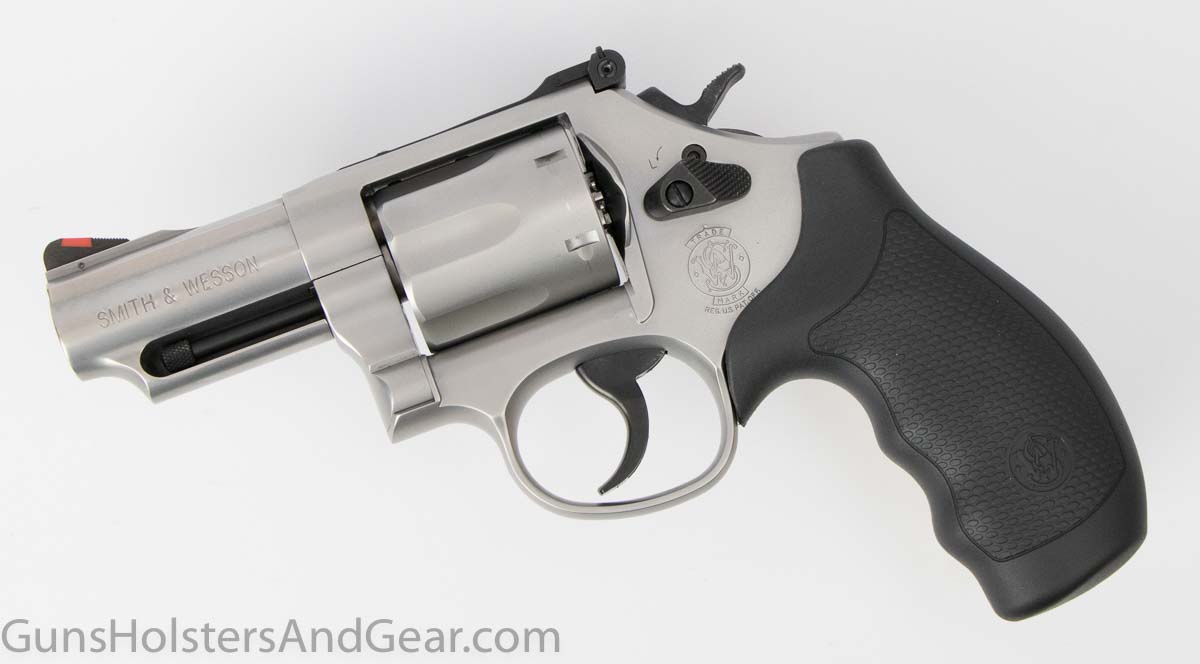
Smith & Wesson is very well known for its revolvers. Many of its wheel gun designs are considered classics and beloved by collectors and shooters alike. Unfortunately, with the rise of the modern auto-loading pistol, the revolver has taken a back seat in handgun sales over the past decades. Consequently, some of the classic designs have been discontinued over the years.
The Model 66 was one of those.
A Brief History of the Model 66
Smith & Wesson introduced the first Model 66 in 1970. Labeled as a Combat Magnum, the revolver was chambered for the potent .357 Magnum. Built on the company’s K frame, the guns offered a balance of relatively light weight and good durability.
The gun was very similar to the popular Model 19, though with a stainless steel frame instead of one made of carbon steel. While the Model 19 remained a hot ticket with shooters and police departments, the Model 66 gained its own following of enthusiasts and law enforcement agencies.
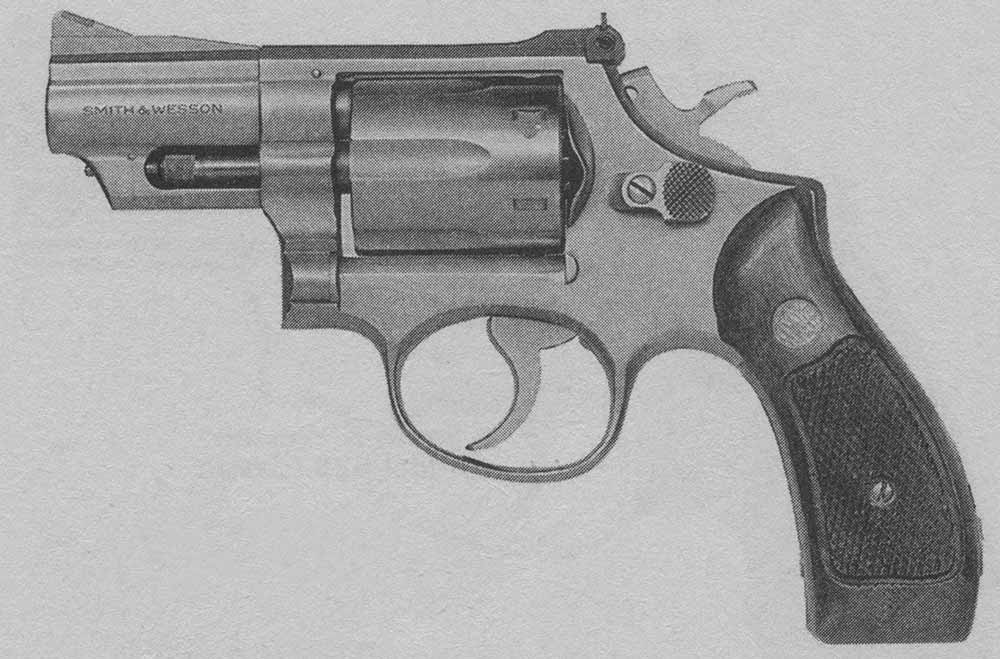
Various changes to the design took place over the years – several significant enough to warrant a model number update. These updated versions are designated on the gun’s frame with a hyphen and number. For example, the first engineering update designated the gun as Model 66-1.
Although it survived in the company’s catalog past the mass transition of law enforcement agencies to the semi-automatic pistol in the 80s and 90s, Smith & Wesson dropped the gun from its catalog in the mid-2000s. (Note: For more information on the history of the Model 66 and all of the Smith & Wesson firearms, I suggest reading The Standard Catalog of Smith & Wesson.)
Customer demand prompted a return of the Model 66 to the lineup in 2014. Equipped with a 4.25″ barrel, the newly released revolver was dubbed the Model 66-8, indicating the eighth major revision.
More recently, Smith & Wesson released 2.75″ barrel version of the Model 66. It was introduced at the 2017 SHOT Show and also identified as a 66-8 revolver. While there are minor differences between the 4.25″ gun and the 2.75″ version, both are essentially the same.
The Modern Model 66-8
The new Model 66 is built on the company’s K-frame, a medium-sized frame that traces its roots back to the 19th century. With more than 100 years of real-world use, the frame design has proved to be a great combination of durability, size and weight.
I’ve always felt that the K-frame revolvers balance very well in my hand. I own several including a Model 10 and Model 64. When the new Model 66 arrived, it immediately felt like an old friend. A little muzzle heavy, the gun still points very well. When shooting a .357 Magnum, a heavy barrel is not necessarily a bad thing. The extra weight can help reduce muzzle flip.
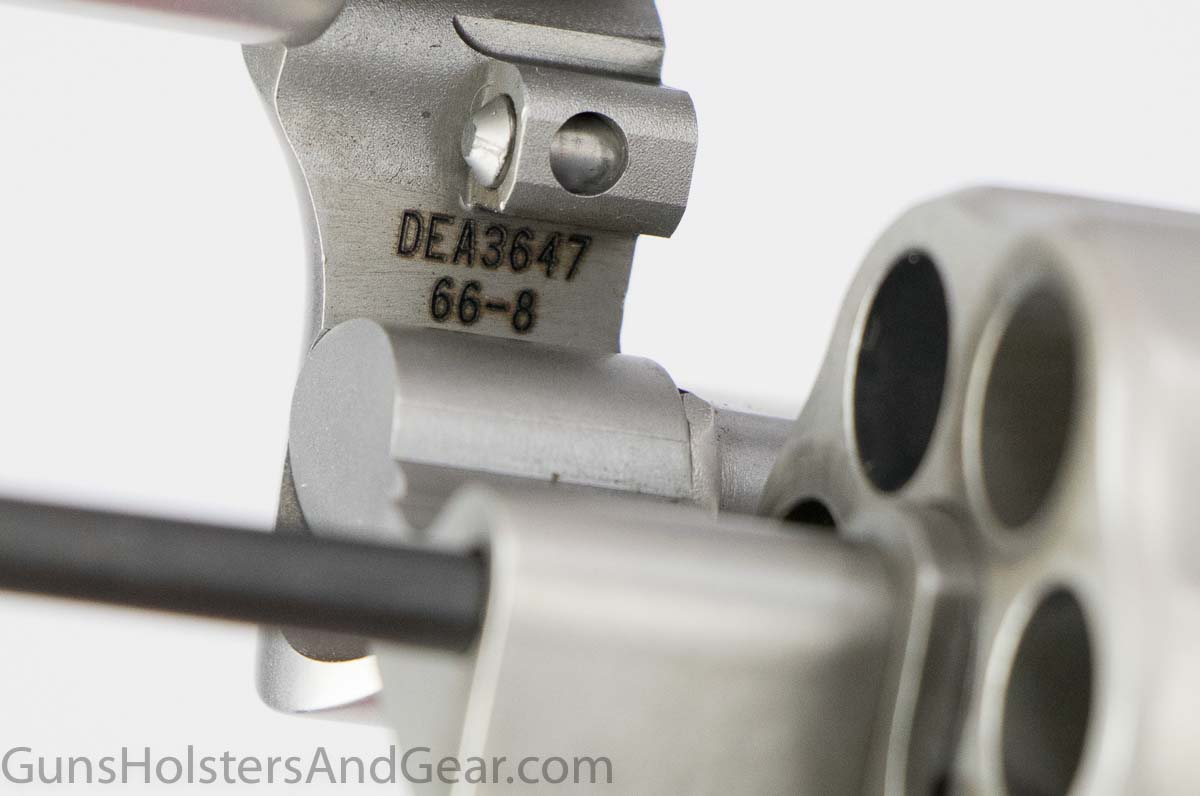
As previously mentioned, the new guns are designated as 66-8 models. As the “-8” suggests, these new production handguns have a number of differences from the earlier production versions of the Model 66.
One of the most significant differences is the use of a two-piece barrel system. Classic Model 66 revolvers used a single-piece barrel that required a greater degree of labor to complete assembly. The two-piece design combines an inner barrel with a shroud.
For a better understanding of how the new two-piece system works, I reached out to Grant Cunningham. Cunningham is a revolver expert – both as a gunsmith and as a combat instructor.
[Compared to a single-piece barrel,] the system can, if properly engineered, tension the barrel and achieve a slight gain in precision,” said Cunningham. “The two-piece barrel can also reduce the labor and material costs in gun manufacturing. Less expensive alloys can be used for the shroud since it is not subjected to the same punishment the inner portion of the barrel is.”
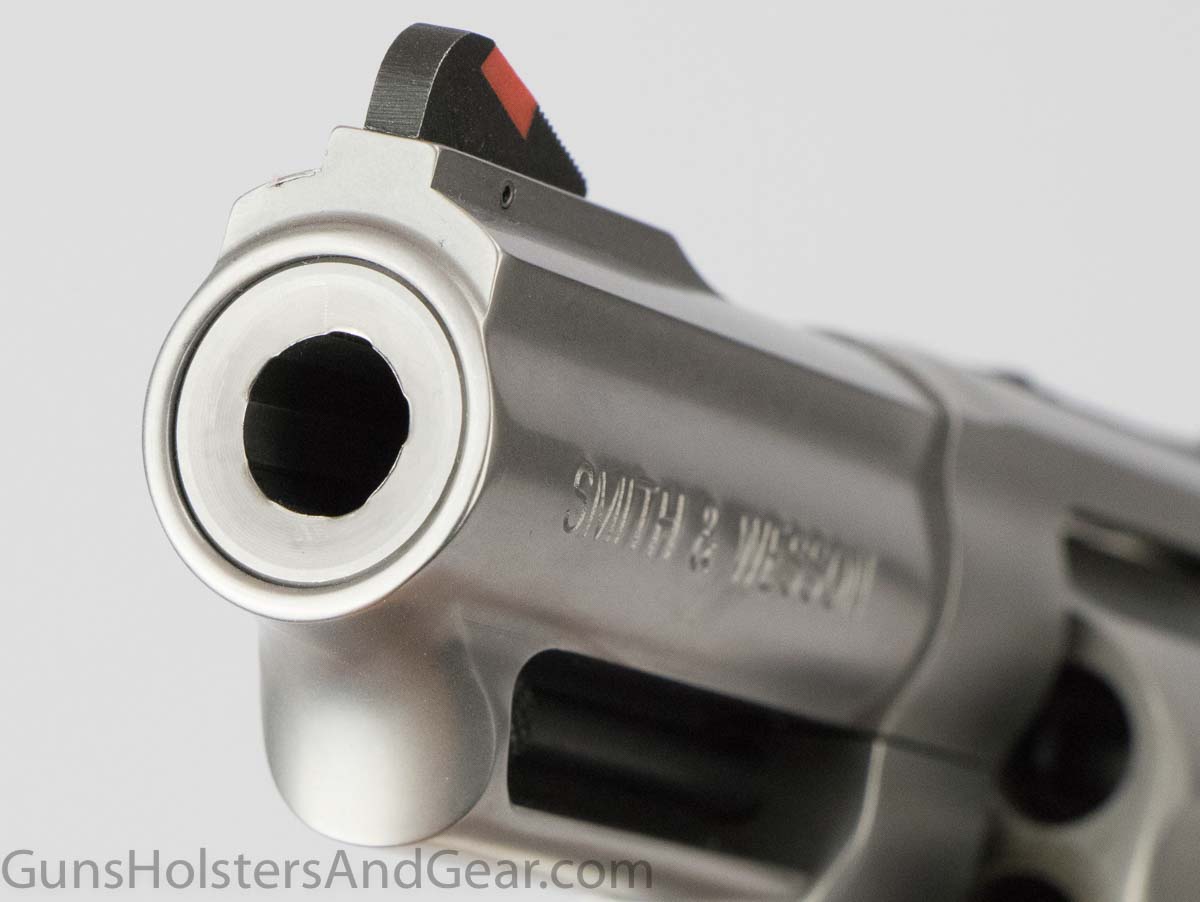
“A very big reduction in cost is the elimination of the very expensive procedure of timing the barrel, getting it perfectly aligned with the rear sight, which requires a lot of hand work,” said Cunningham. “The shroud is indexed to the frame and the barrel is simply screwed in. This reduces assembly time and the skilled labor needed to index the barrel.”
So, if I understand Cunningham correctly, the new Smith & Wesson design reduces the cost associated with production and possibly increases the accuracy of the gun. I think both of those things will set well with the average shooter.
The new barrel design is not the sole change from the original.
Original Model 66 guns offered a full-size cylinder latch release through the mid-1990s. Also called a thumb piece, the release on the 66-8 models is more triangular in shape. While I’ve not experienced any problems accessing the latch in drills, I still prefer the feel of the older thumb pieces.
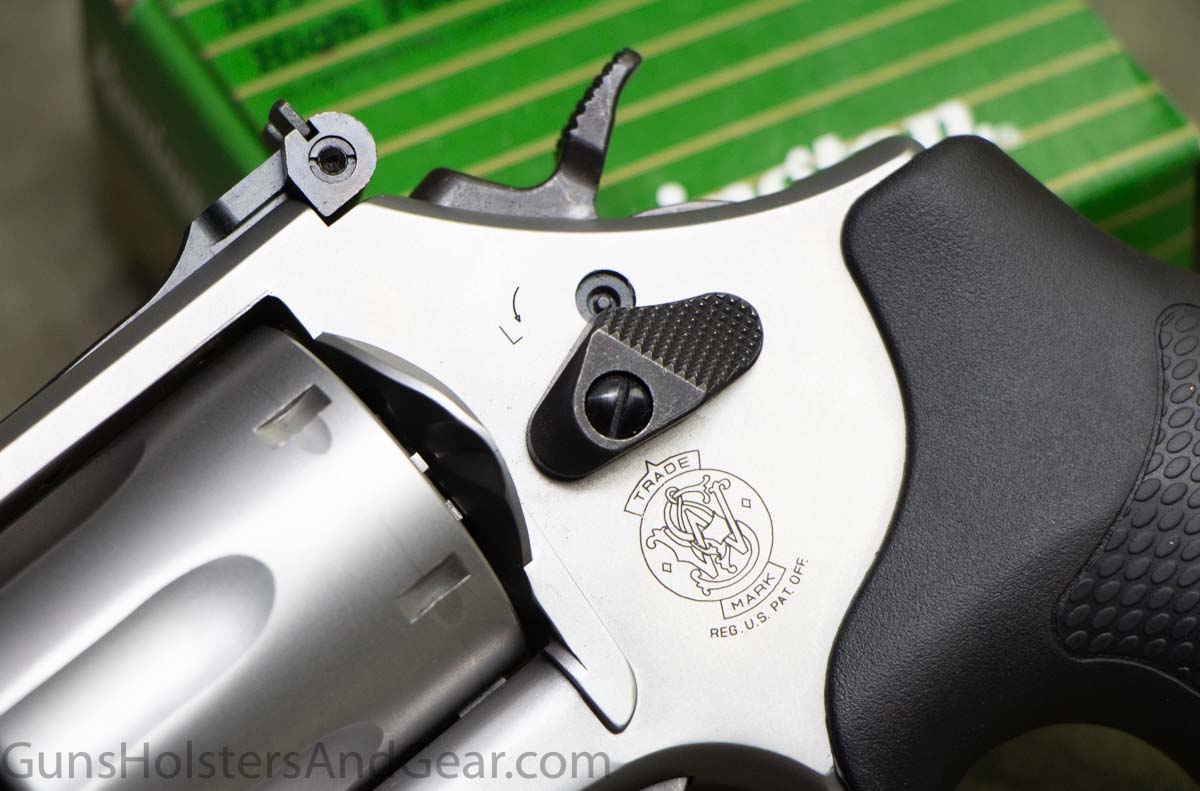
Unfortunately, Smith & Wesson continues to include the internal locks on its revolvers, and it appears to me that the older thumb piece would cover the keyway. So, it would appear that we are stuck with the new thumb pieces for the foreseeable future.
Finish is another difference between new and old guns. While both eras of revolver use stainless steel for the cylinder and frame, the new guns have a bead-blasted matte finish. While the new matte finish isn’t bad, many of the people I’ve spoken to do not like it. At all. Several people have told me it makes the gun look “cheap.”
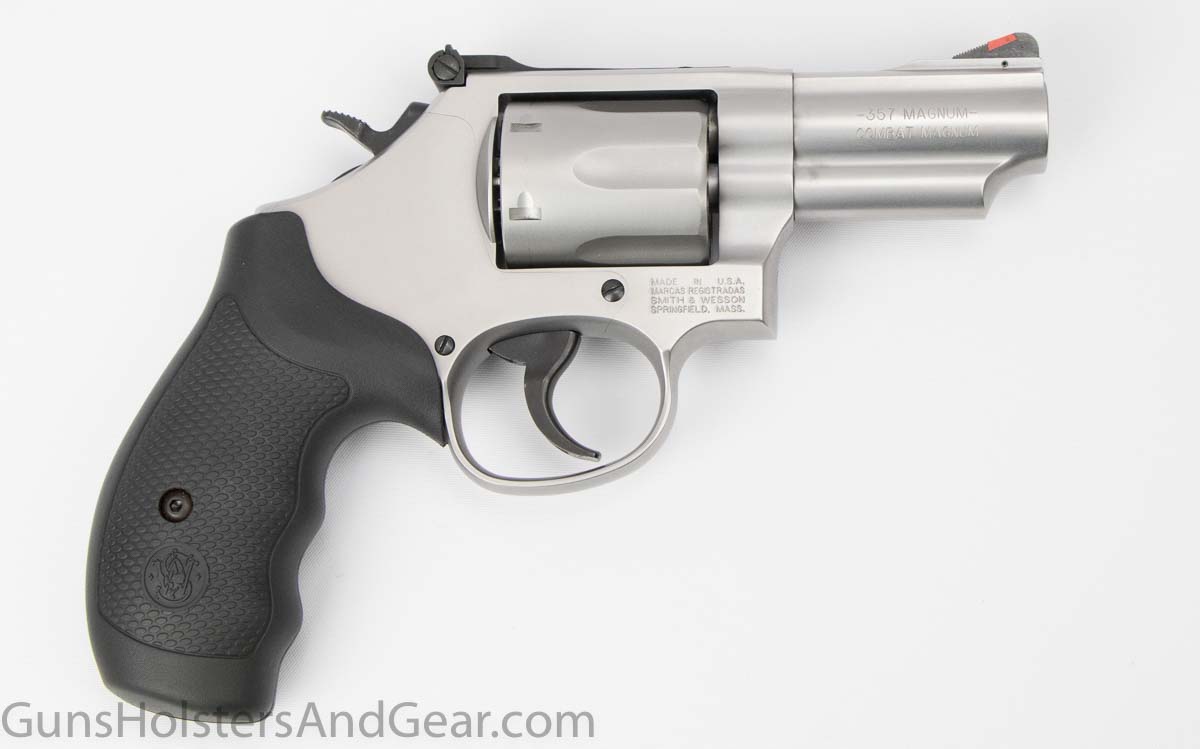
While I have no animosity toward the new finish, I understand how they feel. The older guns do have a good-looking finish, and the matte doesn’t look as good (to me) when compared. I have no doubt that some people will disagree with this S&W 66 review, and that’s ok.
Another difference from the earlier versions of the gun, but one that is not immediately visible, is the use of a round butt frame. Square butt frames were common on the classic Model 66 revolvers until about 1995.
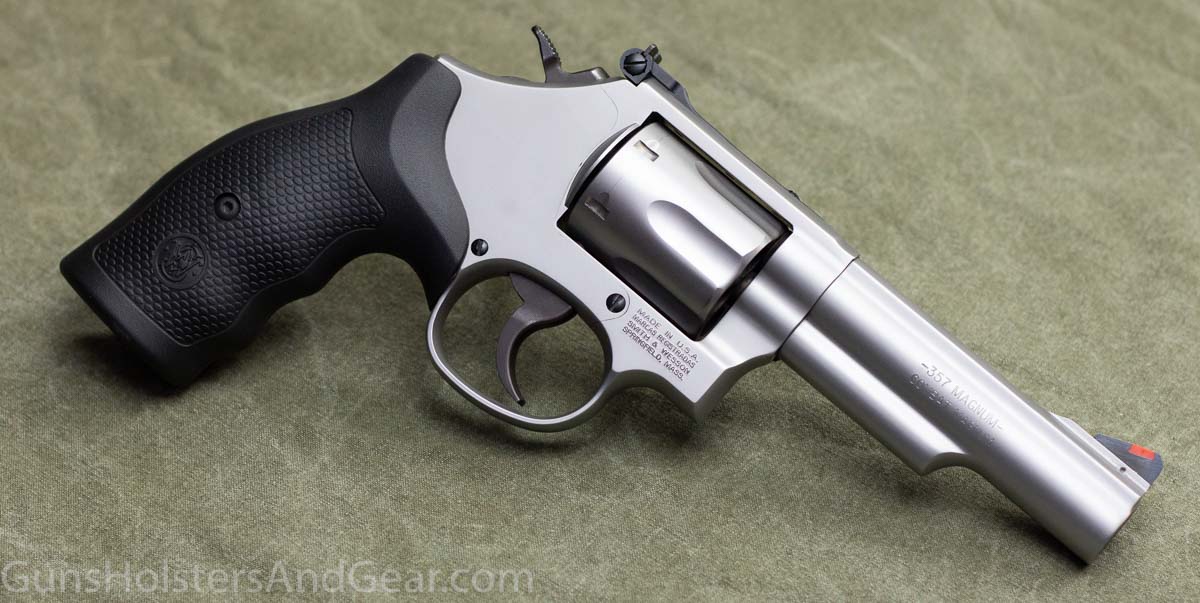
Synthetic grips are standard on the new revolvers. While not as attractive as the classic wood stocks with the S&W medallion, they are well made. A slight amount of excess rubber was visible around the seams of my 4.25″ barrel test gun. The excess did not impact comfort or shooting, but I would carefully remove it from my own gun to improve the look. Even better, originally styled wood stocks would be a nice option for the handgun.
Sights
Smith & Wesson uses a classic, time-tested sight arrangement on the new Model 66. Up front, the company uses a pinned ramp sight with a red insert. Surface serrations and a black finish reduce the possibility of glare when shooting in the bright sunlight. In its center is a red insert. The insert is relatively easy to find quickly in stressful conditions due to its size and bright color.
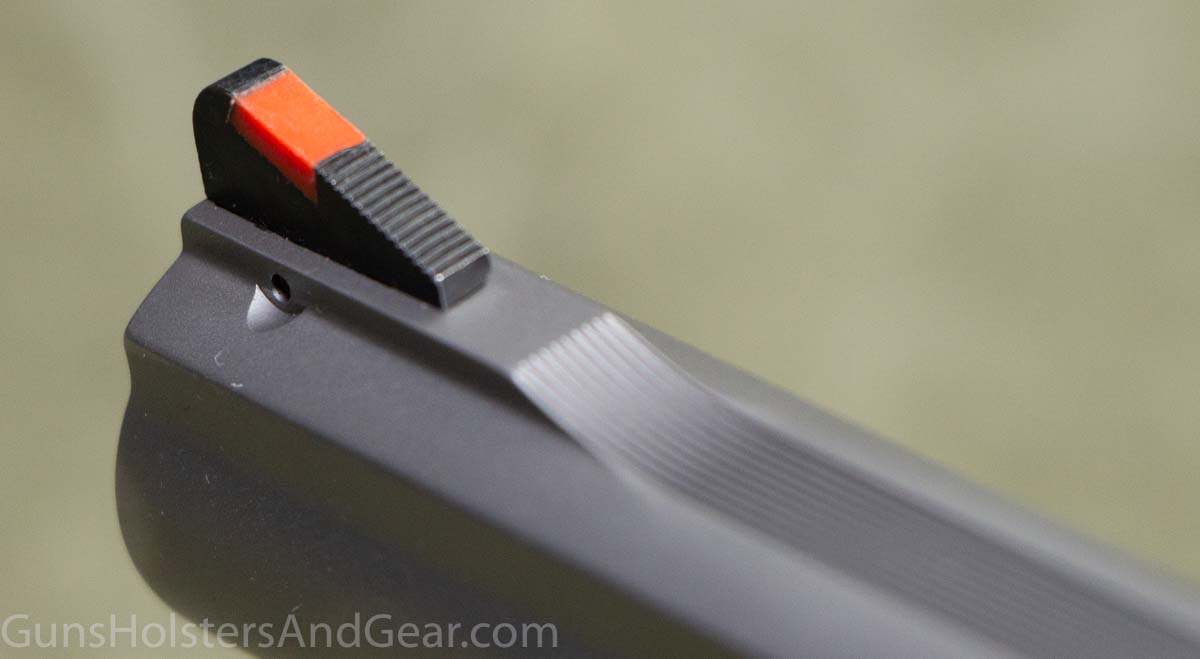
A few years ago, I taught an in-service class at one of the nearby police academies. The class was on vision and threat identification in low light conditions. During the class, I talked about the potential failings of the three-dot sights found on many semi-automatic pistols. When I brought up how well the bright red inserts on the classic Smith & Wesson Combat Magnum revolvers worked, two older deputies in the back of the class sat up and leaned forward, suddenly interested.
After class, those deputies told me that both of them started work for the Sheriff’s Office when the Model 66 was the issued gun. Each related to me experiences in which they clearly remembered that bright red ramp when aiming their guns in violent encounters. Neither could recall ever seeing the tiny tritium vial in the front sight of their current issue 9mm pistol in similar conditions.
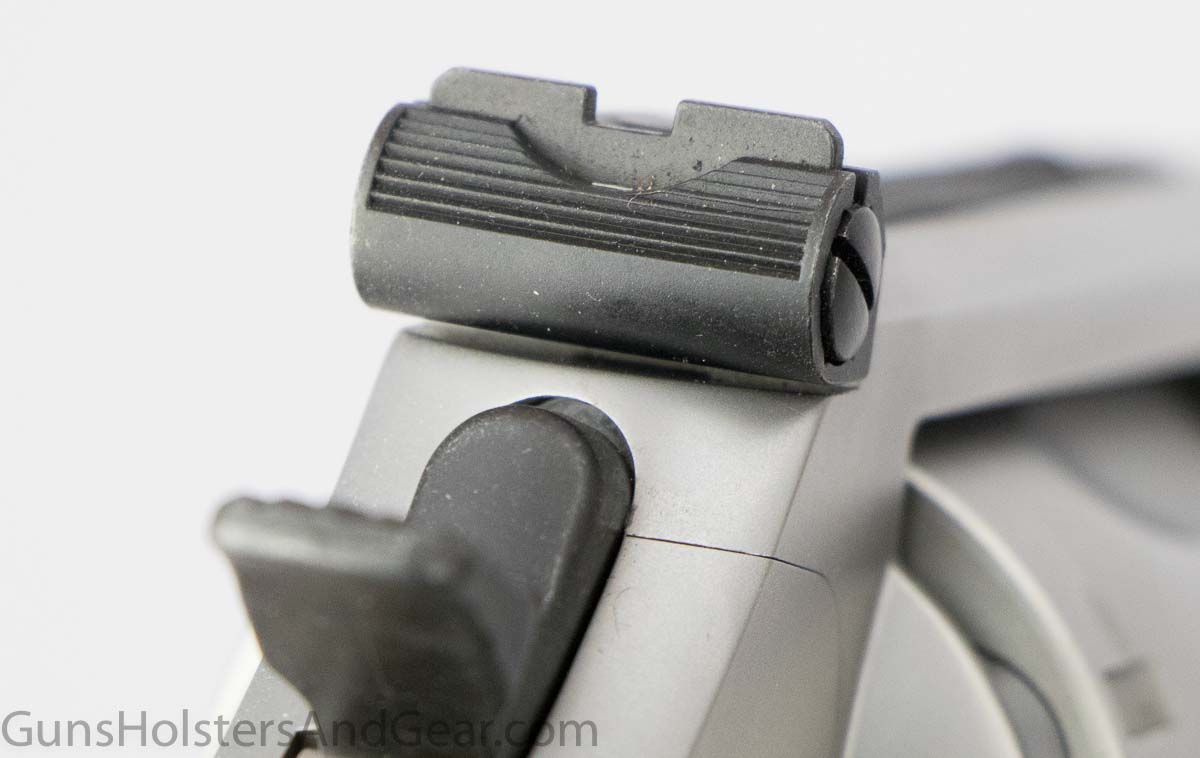
According to the company, the rear sight should have a white outline on all of the new Model 66 guns. The 4.25″ Model 66 had this outline while the smaller gun did not. I personally like the white box on the rear sight, but do not feel that its absence created any problems for me when shooting. The rear sight is adjustable, and the aiming notch is sharp for a clear sight picture.
Reloading the Snub
For the inexperienced, reloading a revolver can be a cumbersome process. It doesn’t help that many of today’s shooters learn how to run a wheelgun by shooting a snubnose revolver.
Snubs like the Model 642, one of my personal favorites, are great for carrying. I feel, however, that snubnose revolvers are guns best employed by experienced, not novice, shooters. While they can be effective combat pieces, they simply are not as good for learning the basics. Recoil is harsher, grips are smaller and stubby extractor rods can fail to remove empty cases fully from the cylinder. All of this can be frustrating for any new revolver shooter.
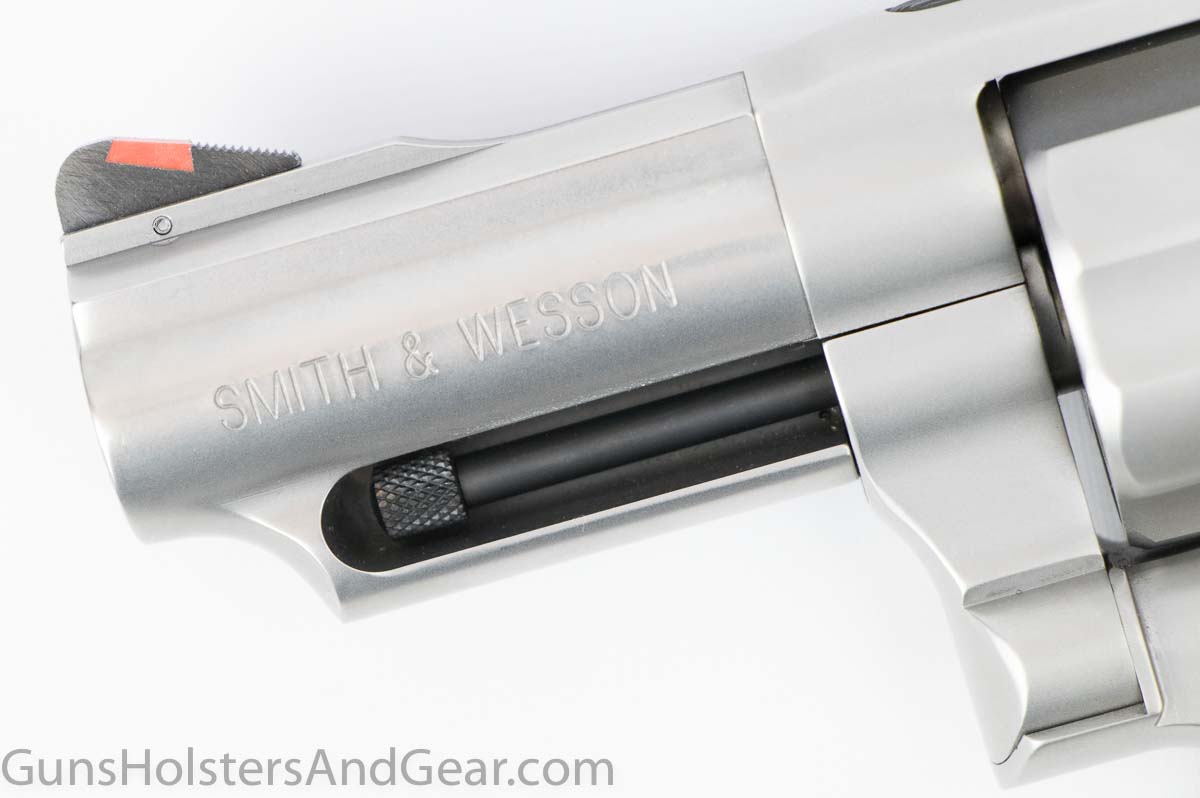
The Model 66 Combat Magnum with a 2.75″ barrel offers all of the handling advantages of a full-size revolver while still being concealable. For example, the gun has a full-length extractor rod that allows for complete ejection of spent cases from the cylinder charge holes. Additionally, the width and balance of the gun allow my medium-sized hand to wrap around the cylinder and perfectly control the gun during a rapid reload.
I was impressed by the perfectly smooth extractor rod movement. Even when hitting the rod from an angle, it slipped nearly frictionless through its channel and dumped spent cases onto the ground. There was not even a hint of dragging. Also, Smith & Wesson uses an extractor rod spring that offers the optimal amount of resistance that is easy to overcome when removing spent cases but still snaps the rod home quickly. Getting excited about the extractor rod function might seem silly, but there are some poor examples on the market, and S&W should get credit for making a great one.
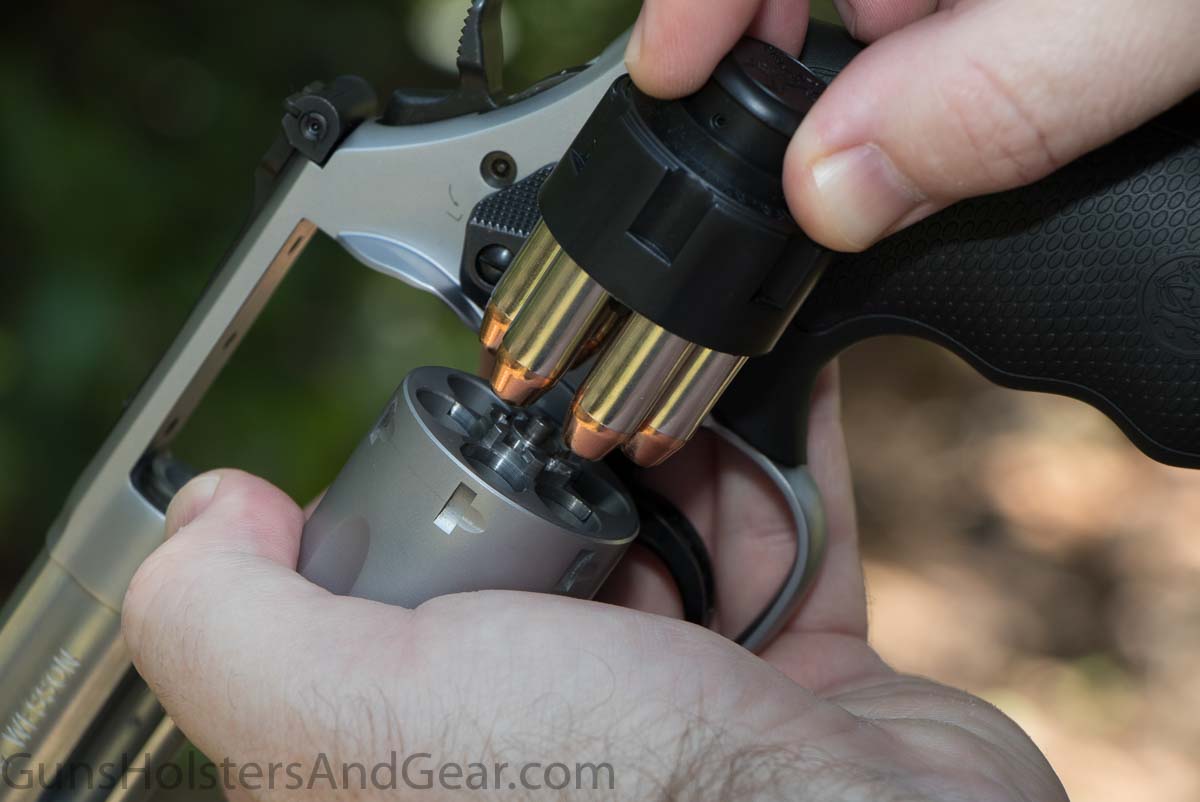
Like I said before, I really like my Model 642. However, the Model 66 is a far easier gun to reload under any circumstance.
Running the Gun
I own a lot of semi-automatic pistols, and really like most of them. But few things are as pleasurable as shooting a really good double-action revolver. While not perfect, both versions of the new Model 66 were a lot of fun to shoot. Accuracy was good on both and reliability was 100%.
Shooting the 4.25″
There is a certain amount of satisfaction to be had when going to a public range with a fire-breathing Magnum and making the plastic pistol crowd stop and take notice. I own, shoot and carry semi-automatic pistols, but I am a bit nostalgic when it comes to duty-sized revolvers.
Making a little noise with one will often start a few conversations with old hands and new shooters alike. I took the 4.25″ Model 66 on several range trips, and every one of them sparked a conversation about the gun.
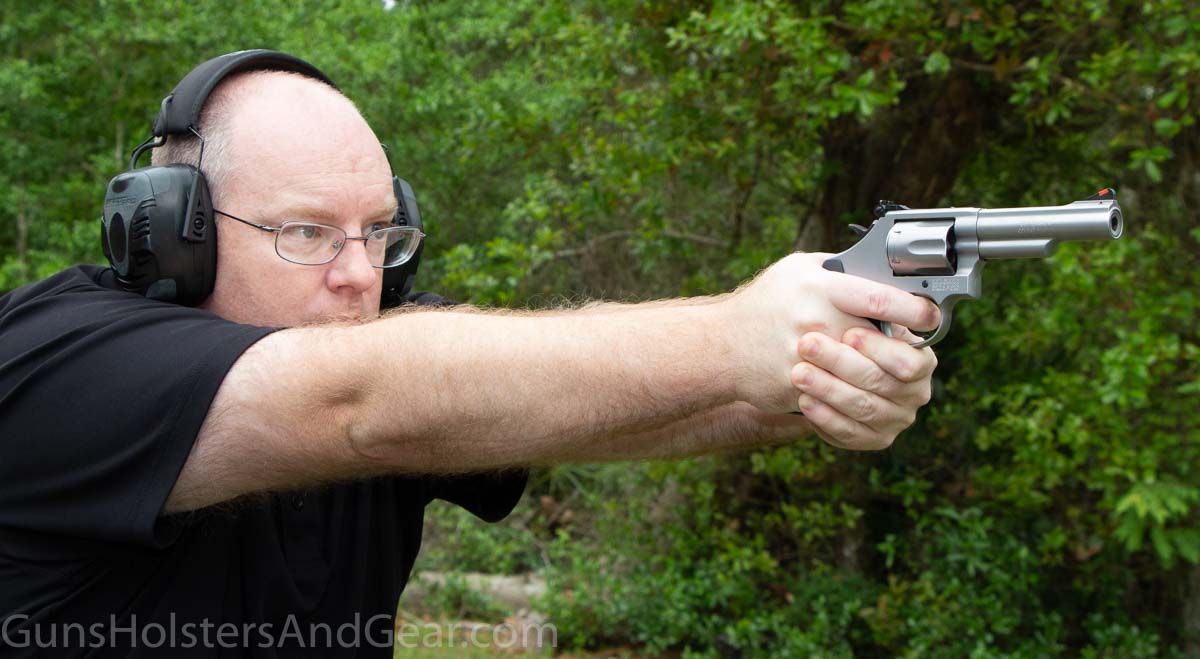
The Model 66 felt good in the hand. I wasn’t sure how much I would like the rubber grips as compared to the old-style wood stocks. However, the grips did fit well in the hand and gave a modest amount of cushion when firing full-power Magnum loads. I was shooting outdoors on a warm Florida afternoon, so my hands did get a little sweaty. The rubber material helped me keep a solid hold on the revolver, and at no point did I feel the recoil was going to slip the gun from my grasp.
Accuracy was good. Shooting double-action off-hand, I was able to get sub-4″ groups at 25 yards with a number of Magnum loads. The best of the bunch was the 125 grain Remington Golden Saber where five shots went inside 3″.
Shooting .38 Special wadcutter target loads really tightened up the groups. With both Sellier & Bellot and Blazer 148 gr wadcutters, I managed 1″ groups off-hand and double-action.
I doubt there are many people that would argue that .357 Magnum recoil isn’t stout. That does not mean that the recoil is not manageable. A solid grip on the gun combined with an aggressive stance can easily help a shooter handle the cartridge’s power.
When rapidly firing, the bright red insert in the front ramp is your friend. The insert seemingly jumps into your field of view and helps bring you right back onto target. At seven yards, a cylinder-full of Magnum rounds will go into center mass as quickly as I can pull the trigger.
Reliability is one of the key features of the wheel gun, and this Smith & Wesson revolver did not disappoint. Every round loaded, fired and extracted as one would hope.
Shooting the 2.75″
Shooting the shorter barreled gun wasn’t much different than shooting its big brother. Accuracy was very similar and reliability was flawless. Visually, the shorter gun made larger fireballs at the muzzle – even in the summer sunshine.
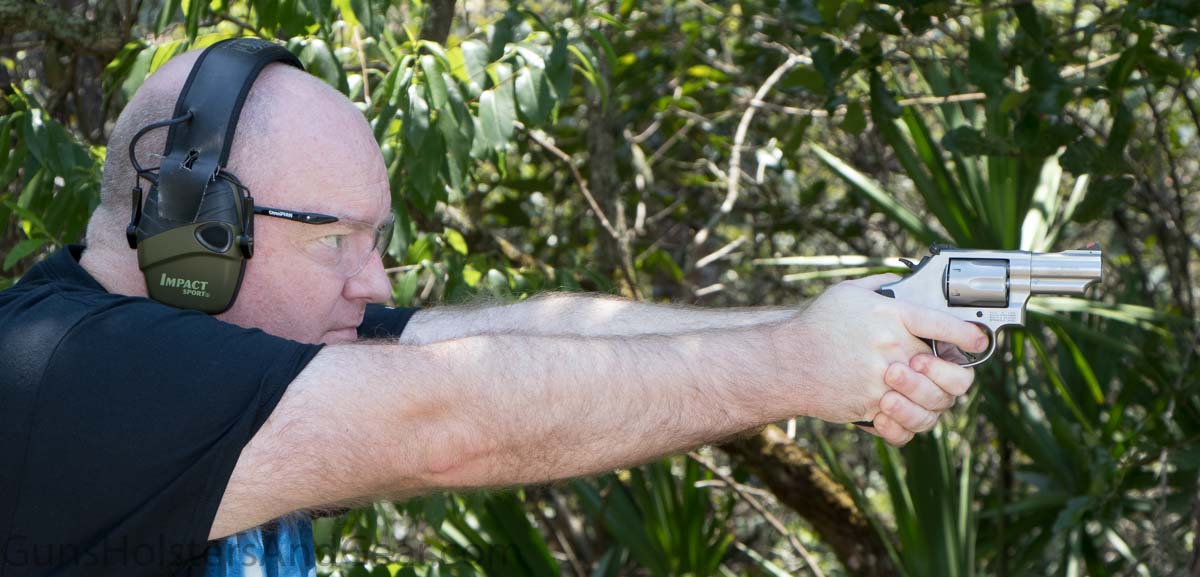
Recoil was quite manageable. In fact, it may have been slightly more manageable in this configuration. I suspect that the curve of the grips may play a role in that. The more rounded lower portion of the grip panels gave my hand a little better purchase. I think this allowed me to have a slightly firmer grip on the gun during shooting.
As a bonus, the grip was comfortable also. It completely covers the backstrap, so it is absorbing some of the recoil impulse while shooting. The stocks do a good job of absorbing the sting that can often be felt in the web of the shooting hand.
Although I typically do not like finger grooves on a grip, these work very well for me. Since the K-frame guns have been around for a very long time, there are many different aftermarket grip choices available to you should the factory stocks not work.
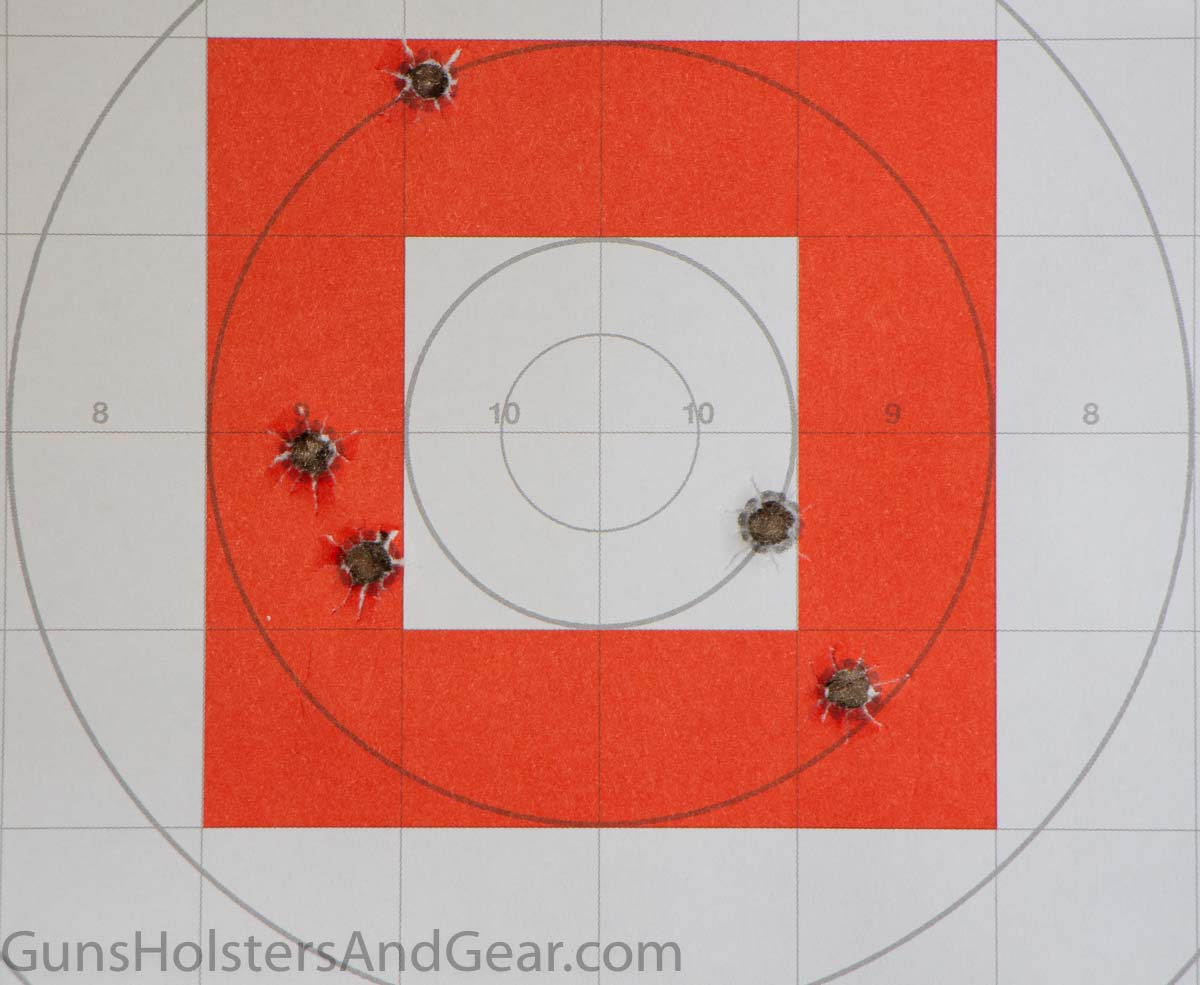
Starting out, the double-action trigger pull was a bit rough. As I shot it, it did smooth out. After about 100 pulls, the trigger was certainly acceptable and equal to the pull on most service revolvers. Initially, I felt this impacted my accuracy, but once it smoothed out, it was not an issue. In contrast, however, the single-action pull was light and crisp right out of the box.
For a combat revolver, I prefer to shoot double-action-only. While some instructors will disagree, I strongly feel that practicing single-action shots on the range is of dubious value. While shooting in single-action mode off of a bag would almost certainly tighten up the groups, I still was shooting 2-3″ groups rapid-fire from double-action mode with full bore Magnum loads at 7 yards.
I hate to speak in cliches like “combat accuracy,” but this Combat Magnum is more than accurate enough for personal protection. You do your job, and it will do its job.
Ammunition Performance
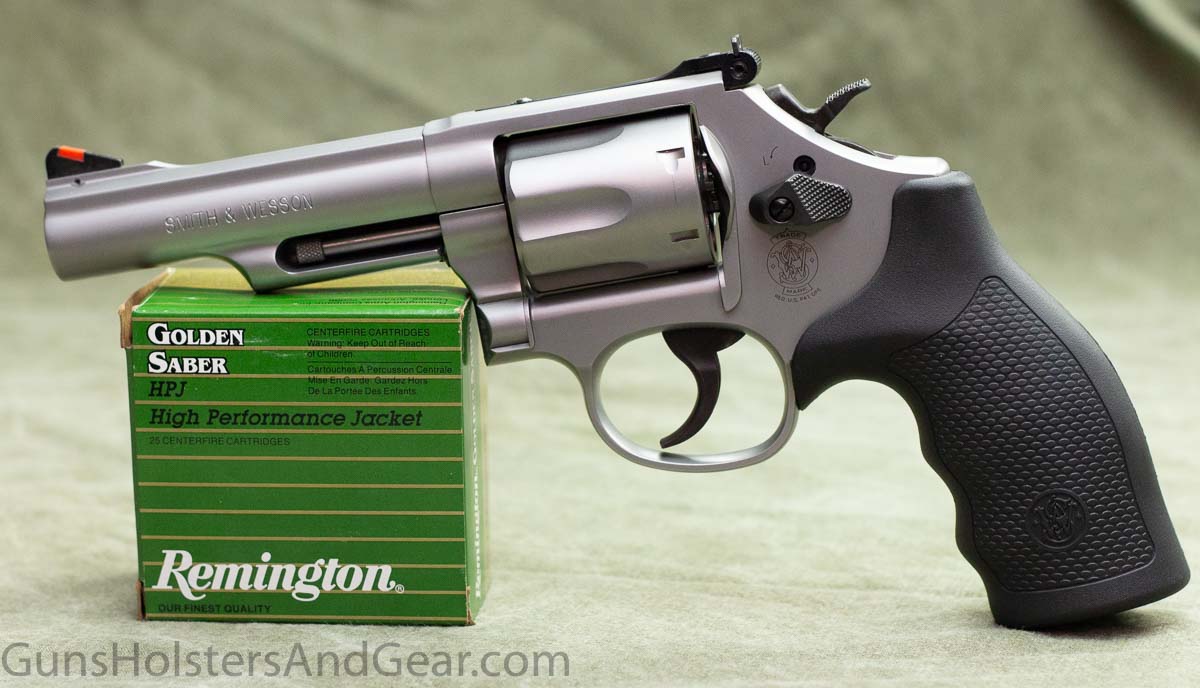
Ammunition performs differently from different guns and from different barrel lengths. The following information is provided to give you a sense of how some brands and loads may work from these guns. The first table shows ammunition shot from the 4.25″ barrel version of the Model 66-8:
| Velocity | Energy | |
| .357 Magnum | ||
| Federal 158 gr JHP | 1,191 fps | 498 ft-lbs |
| Remington Golden Saber 125 gr JHP | 1,240 fps | 426 ft-lbs |
| Speer Gold Dot 158 gr JHP | 1,023 fps | 367 ft-lbs |
| .38 Special | ||
| Aguila 148 gr WC | 624 fps | 128 ft-lbs |
| Blazer 148 gr WC | 699 fps | 161 ft-lbs |
The second table shows ammunition shot from the 2.75″ barrel version of the Model 66-8. Unfortunately, I shot the guns on different range trips and failed to shoot the same loads from each gun for a better comparison.
| Velocity | Energy | |
| .357 Magnum | ||
| Hornady Critical Defense 125g gr FTX | 1,201 fps | 400 ft-lbs |
| Remington Golden Saber 125 gr JHP | 1,197 fps | 398 ft-lbs |
| Speer Gold Dot 158 gr JHP | 1,045 fps | 383 ft-lbs |
Conclusion
The name Combat Magnum evokes a certain image. From unflappable lawmen to a parent protecting his or her family, the name suggests a surety of action from an age of common sense and reason.

The Model 66 Combat Magnum is just as relevant today as it was when it was introduced many moons ago. It is still a reliable performer in uncertain times, and six rounds of .357 Magnum ammunition remain extremely effective against all kinds of predators. With a 2.75″ barrel, the new Model 66 is an excellent choice for concealment. The 4.25″ model offers exemplary service as a home defense weapon.
The new versions look good, and more importantly, shoot well. For all but the die-hard purists, the new Model 66 will please anyone looking for a duty-sized .357 Magnum revolver. Even the purists will have to admit that while the gun is not an exact duplication of the original Model 66, it is well made and fun to shoot. They may not be perfect reproductions, but they are both combat-ready for today’s self-defense shooter.

Where to Purchase a S&W 66
The S&W 66 can be ordered from any dealer close to you and via our affiliate links:
- Palmetto State Armory: 4.25″ model, 2.75″ model
- Guns.com (both new and classic models)
- Sportsman’s Warehouse: 4.25″ model, 2.75″ model
Last update: September 2, 2021
Disclosure
Shockingly, few authors or publications offer a disclosure to inform you about potential biases that may influence the review. I take a different approach and clearly explain those biases.
Both of the revolvers in this article were loaners from Smith & Wesson. I wrote two different articles about the guns (one on each) for Combat Handguns magazine. I have reprinted some of the material here from those articles, but much of it is new. However, the conclusions are the same.
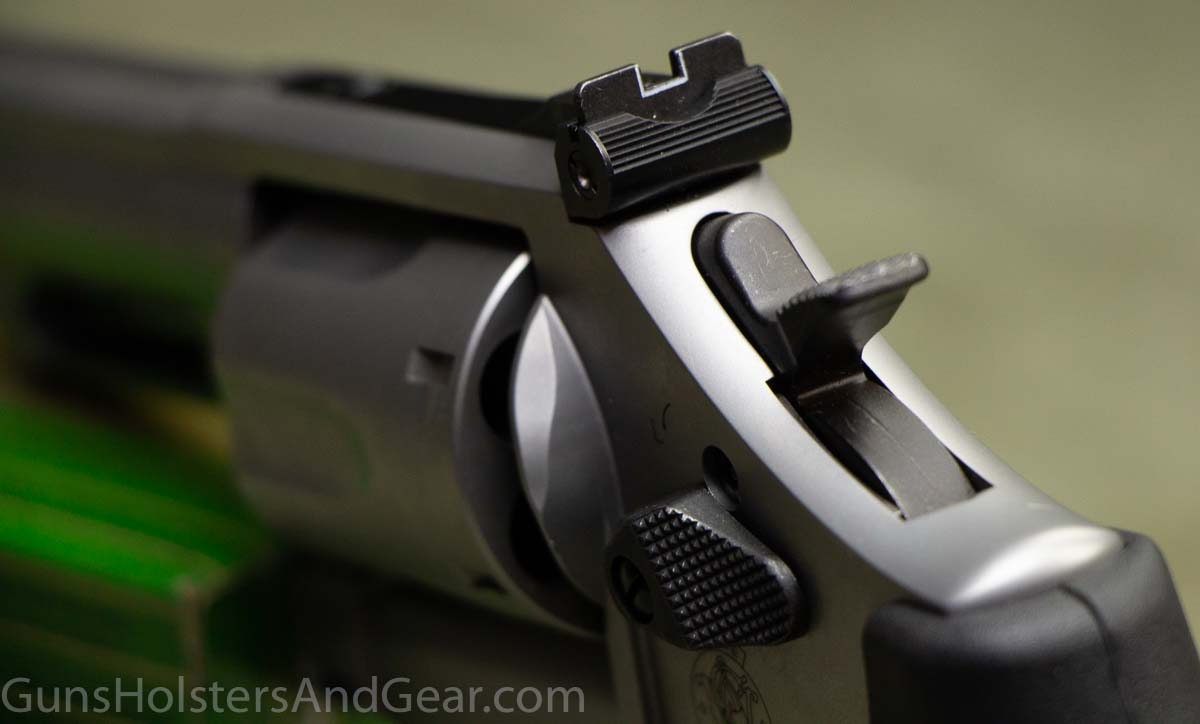
The company did not pay me to write this S&W Model 66 review, nor did it request a favorable review of the guns. It is not an advertiser.
This is not a sponsored review. Sponsored articles are another form of advertisement, though one which frequently masquerades as editorial content.
I do not have any financial interest in Smith & Wesson or any other firearms manufacturer.
GunsHolstersAndGear.com is a for-profit website. I do not charge readers a dime to access the information I provide.
Some of the links on this page and site are affiliate links to companies like Amazon and Palmetto State Armory. These links take you to the products mentioned in the article. Should you decide to purchase something from one of those companies, I make a small commission.
The links do not change your purchase price. I do not get to see what any individual purchases.
Any questions about this Smith & Wesson Model 66 review? Have one of the guns and you want to share your experiences? Please use the comments section below. I merely ask that all comments remain civil and free of profanity. I’m trying to run a family site and hope you can appreciate that.
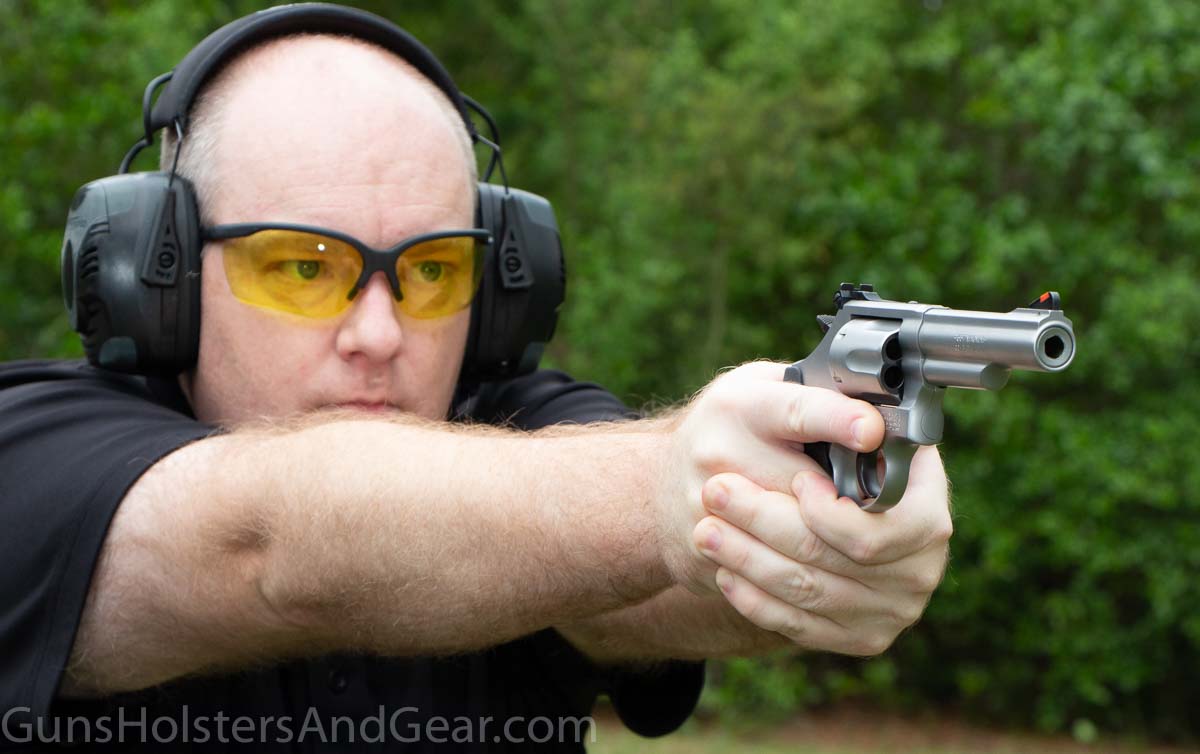
32 replies on “Smith & Wesson Model 66 Review: The Modern Combat Magnum”
I have a model 66 6 inch barrel I purchased around 1990s . I took my wife to the range let her shoot it next thing she said, sale mine am keeping yours. She shoots my 617 as well. Thanks for history
Hi Joe,
I’ve found myself in very similar situations!
-Richard
I have a model 66 I carried for over 20 years in the 70s to the 90s. I still carry it sometimes. 2.75 inch barrel and round butt.
Richard thank you for your excellent reviews! They are much appreciated and a refreshing change from many found online. I share your love of SW revolvers and appreciated your coverage of these two. I have a newer 69 (4″ barrel) that I am very fond of.
Thanks Paul! I am working on my review of the recently re-introduced model 610 right now. If you’re not familiar with it, it is an N-frame chambered for the 10mm. It’s another fun shooter that scratches my “be different” itch. I should have it up in the next couple of weeks.
-Richard
Now if Smith would just make it without the lock I’d buy one. The lock is a deal breaker.
I’ve owned a 66-6 S&W .357 S/S for several years now. Was wondering what is the difference between a 66-1, 66-2, 66-4, 66-8? Never see the 66-6 listed in any forums or any gun sites!
The 66-8 is the current production. It has the two-piece barrel in 4.25″ or 2.75″ Mine doesn’t have a white outline rear sight. Good SA/DA pull with no grit. My only complaint is it takes a new holster (4.25″).
Well written review but you left out the single most important engineering change to the new Model 66. The thin forcing cone of the old models that were prone to splitting with a steady diet of the 125 grain Hydroshoks that were the standard back in the day has been substantially strengthened. These new model 66s may not be as pretty as the old ones but they will last a hell of a lot longer with heavy loads.
I just picked up a Model 66-6 with 4″ barrel. I haven’t had a chance to take it out to the range yet. But I’ve read about this propensity for cracking on the forcing cone. How common is that? Is it a result of cranking lots and lots of higher power rounds through it? Thanks for input.
I have a S&W Model 66-1, 6 inch .357 that I carried for 13 years as a my duty weapon (I’m retired police officer, 33 years – my last 25 with Houston P.D.) I obtained this from a widow of a Denver P.D. robbery detective who’d killed a robbery suspect in a “Dirty Harry” style shootout with this gun in 1973. Unfortunately he was wounded in that shootout and succumbed to his wounds a few days later. She wanted to just give his gun away but I insisted she take some sort of compensation and she accepted $25. I carried that gun for the next 13 years before I had to relent and start carrying a 9mm semi-auto Sig Sauer (I had arrested 2, 13-year old boys who each had a Mach 10 with 30 round clips – I was “outgunned” to say the least by those 13-year olds). That Model 66 remains my favorite and it is such a pleasure to take to the range. I’ve never had an issue with it in the 47 years I’ve had it.
I just purchased a S&W, model 66-1, serial number 52K9603 and it appears that it has never been shot. I would appreciate any info you can give me-manufacture dates- prices etc. The main thing I would like info. on is that it is a comemerative model for the Arizona Highway Patrol-1931-1981. Thanks.
Hi David,
Your best bet is to go through the Smith & Wesson Historical Foundation. This organization is approved by Smith & Wesson to provide historical and authenticity letters and other information. The letters are researched and issued by Roy G. Jinks. Requests can be made here: https://www.smith-wesson.com/firearm-history-request
I hope this helps.
-Richard
Cool story bro. Too bad you’re full of it. No retired or active duty LEO refers to a magazine as a “clip.” Great article though. Thanks for the history.
Somebody had better teach that Brooksville Police Department cop how to properly hold a revolver before he permanently amputates the tip of his left thumb. One NEVER puts any fingers/body parts next to the front of the cylinder of ANY revolver, let alone one with the power of a .357 Magnum!
The super high-velocity/high-temp gasses and unburned powder that normally excapes from the gap between the barrel’s forcing cone and the front of the cylinder when a revolver is fired will literally act like a scalpel and cut away large chunks of flesh from whatever is in even semi-close proximity to that area on the sides of the revolver. The higher the power the round is, the more distance and care needs to be taken in this respect.
If you are ever using a revolver in a defensive situation and the hammer is already back/the cylinder has already spun to the next loaded chamber. If somebody should grab the handgun in an attempt to disarm you, just fire the round that is in place. I guarantee they will no longer be holding your weapon due to this side-blast effect. Even if the bullet misses them by a country mile, the attack will probable be 100% over with too because you probably just did the equivalent of hitting the perp in the palm with a small axe with the way those gasses “cut”.
One would think you could find a cop that knows how to shoot a revolver to take a picture for this article holding the revolver.
Hi Pat,
Thanks for taking the time to read the review and post your observations. While the angle of the photograph appears to have given you the impression that the officer had unusually long thumbs, I can state the end of his thumb was well to the rear of the front of the cylinder.
Thanks again for reading and pointing out the valuable information about revolvers. Too few folks shoot wheelguns nowadays and what was once common knowledge seems to have evaporated.
Richard
I thought the exact same and chalked it up to handling too many plastic semi auto pistols. I carried a model 19 pinned and recessed 2 1/2 in barrel as an immigration officer from 1978-82 in Laredo, Tx port of entry. My son got it stolen and I replaced it with a 66-3. What a revolver!
I have my service model 66-0 from the police department, they gave me when I retired after 30 yrs. It’s still in good shape after a few times going to the range and my wife use it a few time she said time to retire it from the range. the model is 66-0 357 2.75 bbl SS. Just wondering any history on this model, I know their is a lot of model 66.
Excellent review, thank you for not using the term “run”, engines run, guns shoot! I had a 6″ M66 back in the day and sold it for money to buy another Colt 357. I figured I could always replace it, WRONG. Today, 5-10-2022, Combat Magnums are impossible to find and believe me I know all the places to look online. I found a brand new 4″ by manually cruising the shops within 50 miles of my house is South Florida and had to pay $950 for it. Money well spent.
I have a model 66-1 with a 2.75 inch barrel and rounded butt. I’ve had it since the 1970s. It was an excellent weapon, with the firepower of a .357, but you could shoot .38 Special, which in the old days was cheaper. The rounded butt and short barrel made it very concealable and the stainless steel finish meant it could be against your skin and no worries about corrosion.
I still own the model 66, no dash, I carried as a young officer. It is in excellent shape except for a tiny bit of holster wear on the edge of the barrel. I carried it for a few years before we switched over to the 9mm. I have only shot it a few times since it’s retirement from duty.
Thank you for the review. I am shopping for a new revolver to replace a 2” .357 I have carried for several years. I prefer a heavier and more accurate gun. I know it’s heavier and larger than most people prefer, but it’s my preference. Are you familiar with the S&W Combat Masterpiece? I carried one while in the USAF and am now the proud owner of one. It’s Parkerized and stamped USAF on the frame. Maybe you can review it sometime. Thank you.
4″ Model 66 since 1982. It has been a constant companion from one end of Alaska to the other over the last 40 years. Deep cold, wet, marine, desert dry. Pick an environment and don’t worry. Wipe down occasionally with oil or RIG. Mine wears Hogue. Couple of black bears, caribou, pickup load of small game, and one coyote too far away. It has fed me a time or several. Lives in my travel bag and goes where I do. ’72 vintage model 19 stays by the bed where rust is not a concern. Great choice for an outdoorsman go to sidearm. Not too heavy & easy to shoot. Choice of holsters, grips, & stocks and wide variety of loads for any purpose. Not flashy or sexy but solid and as reliable as the sun coming up every day.
Over the years a model 66’s forcing cone would crack due to firing hot 357 loads such as law enforcement use. Hence stopping production. This is where the 686 model L frame came into production. I’m curious to see if they beefed up the forcing cone crack area or thinking maybe a person will not shoot such hot loads ( 125 grain) loads that law enforcement were constantly using.
I have purchased a new Smith & Wesson 66 online last week. Reading about the forcing cone made me think twice about this purchase. In CA you have a 10 day wait period before picking up the gun. Also, in this case it has to be shipped to my local gun store before I can actually take a good look at it. Once I can review it I will at that time decide whether I will keep it or get my money back. I also own a Smith & Wesson 686 that I purchased last year. Nice review on both revolvers but for some reason I just don’t care for any revolver barrel length under 4 inches!
Good article. Thanks. I appreciate you not touting either model as a “winner” or better or worse than other models available for “home defense” etc. I have at least one model of just about every modern handgun being sold. Lots of different Glocks and 1911s. I carried a Model 19 in a Bill Jordan Border Patrol holster for many years as a patrolman back in the olden days. I had to leave it with the department I left.
I have an old Model 66 in a Safariland Model 10 now. Still a favorite. I can still draw and fire that rig very effectively; like a gunfighter in a western movie. It is a very special combination. When evaluating handguns, I think not enough goes into looking at the purpose which drove the gun to be created and how it fulfilled that purpose, or not.
This particular gun and rig was THE pinnacle of patrolman carry in its day. Later, focus on gun retention put quick draw holsters on the back shelf. High capacity soft shooting and ultra reliable 9mm pistols made training cops so much easier. But, if I ever had to face off with a gunfighter, I’d be more afraid of the guy that looked like Bill Jordan w this rig than I would of the guy carrying a Glock in a safety holster with 5 spare magazines strapped all over his chest.
I was a little disappointed in those velocity and ftp energy numbers that you posted. I have a Glock 24 wich is Glocks match pistol in 40S&W. I am an avid loader , and am getting better numbers by alot when using just factory Underwood 155 grain ammo. Of course the G24 has a 6.02 inch barrel and an enclosed chamber with no cilinder gap loss like a revolver. I am getting right on the 600 ftp energy mark. Could it be the ammo you used?
He was shooting major-brand “combat”/”tactical”/”defensive” .357 loads. Not full-house Underwood/Buffalobore .357.
It’s a big benefit of revolvers: The cycling is manually powered, so they’ll fire and cycle anything from the weakest primer-only duds, to the most firebreathing concoction from boutique brands and handloaders.
Sir,
Excellent article about what I consider to be a premier firearm. I have a Model 66-2, purchased new by my father in 1980. It feels better in my hand than any other pistol I have fired. I especially loved your comment about it being noticed at the range; this has happened to me on many occasions when shooting Magnum loads. You can keep the plastic guns, i’m a fan of machined steel!
I’m a retired sergeant with 35 years of active duty who carried every smith and Wesson revolver availability with a 295 career average on monthly qualifying. I also was shot in chest at point blank range that I was blessed to survive. As an aside I was shot by .38 super vel but the lord was with me that day. I worked in south central l. A. Most of my career so my revolver was out of its holster a lot. This article is a A+ in my opinion.
Excellent Review I just purchased one. Mine does not have the White outline on back site??
Great article, I have a model 66-8 and have shot everything from light loads to 180 gr bear loads. Mine is a 4.25 barrel. It’s my favourite.